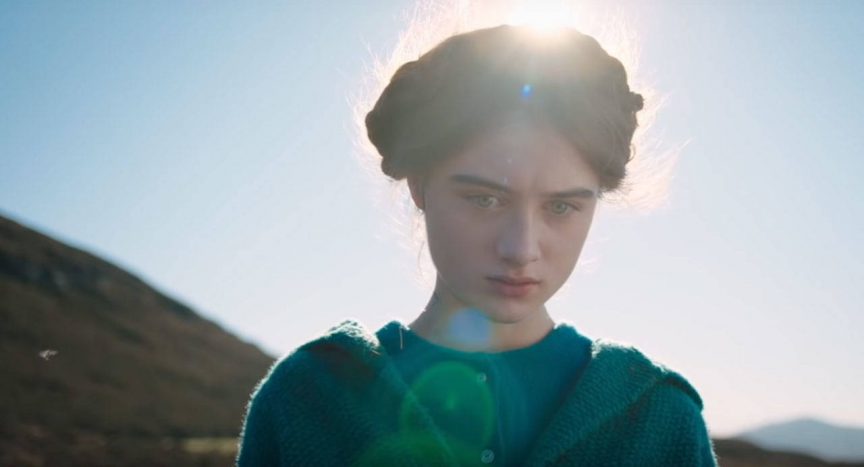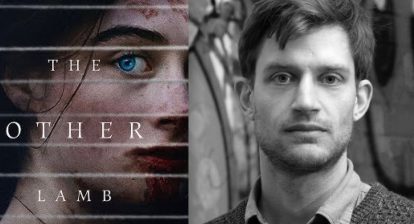My parents sent me to a Catholic all boys high school to “avoid distractions.” What “distractions” means, if you haven’t been indoctrinated into the bizarre sexist code of America, is “healthy relationships with women.” At that Catholic all boys high school, I was taught that when Eve ate the apple she committed the “Original Sin.” All of humanity would be punished, but women especially. They would have to have periods every month and painfully birth children. (Forgive me if I’m fuzzy on the details. It’s been ten years.) Malgorzata Szumowska’s first English language feature, The Other Lamb, demonstrates the way the concept of “Original Sin” has been and can be used to other and denigrate women.
The main character, Selah (Raffey Cassidy from The Killing of a Sacred Deer), is born into a Christian cult. The leader, known only as Shepherd (Game of Throne’s Michiel Huisman) for most of the film, is her father. In fact, he’s the father of many of the other young women in this cult. The rest of the women are his wives. There are no other men. “Only one ram in a flock, child,” Sarah (Denise Gough) explains to Selah late in the film.

That scene is brilliantly shot, as our many in The Other Lamb. As the women circle the Shepherd, screaming for his attention, the camera spins. The throng tightens. The camera rotates faster. Their voices blend as their faces blur. When it feels like it can’t go any further, the camera suddenly turns to the sky and the sound cuts out. The frenetic shot echoes the emotional roller coaster these women are on.
Selah is one of the first to have the blood put on her cheeks in that scene. The Shepherd has been treating her better than the other women because she’s a teen who still hasn’t had her period. He interprets this as a sign of her innocence and pureness, which she internalizes. When she’s asked to bring food to a structure where women on their period are forced to stay and fast for the duration of their monthly cycle, Sarah confronts her. Speaking truth to power, Sarah tells Selah, “You think because you haven’t had your time yet, that you’re special.”
When Selah’s time eventually comes, the Shepherd wants to have sex with her. He makes this clear by staring at her while having intercourse with other women. He makes eye contact with Selah as he shoves two fingers into another woman’s mouths until she gags. It doesn’t matter that Selah is his child and it would be incest. It doesn’t matter that she’s a child. The Shepherd is a reprehensible man whose heart wants what it wants. (Quick f*** you to Woody Allen.)
 Raffey Cassidy is excellent as Selah, who doesn’t know what she wants. The Shepherd and the women of this cult have raised her since birth. She doesn’t know another life and she likes the way the Shepherd treats her. She’s the favorite, after all. Cassidy embodies Selah’s naivete, and later her confusion and eventual power perfectly.
Raffey Cassidy is excellent as Selah, who doesn’t know what she wants. The Shepherd and the women of this cult have raised her since birth. She doesn’t know another life and she likes the way the Shepherd treats her. She’s the favorite, after all. Cassidy embodies Selah’s naivete, and later her confusion and eventual power perfectly.
Szumowska gets a great performance out of Denise Gough as Sarah too. Gough’s character is also in a tough place. She’s being punished for what the Shepherd perceives as “vanity” but she’s been in this cult for at least Selah’s entire life. While she no longer believes in the Shepherd, she’s too afraid to leave. Gough lets that bitterness flow through her performance.
Both Selah and Sarah are dressed like characters in The Other Lamb’s ideological cousin, The Handmaid’s Tale. The wives in this film wear red robes, while the daughters wear blue.
RELATED: Looking at Hulu’s The Handmaid’s Tale Through the Eyes of Feminist Horror
The Other Lamb draws imagery from Robert Egger’s 2015 The Witch as well. Both films are centered around religious extremists in the woods. Both films have many massive shots, showing the characters walking through the wilderness. The people make up a tiny part of the shot composition, demonstrating how small humans are next to the grandeur of nature. These wide nature shots give viewers time to think about the film, but also slow the pace considerably.
RELATED: Why The Witch Deserves Your Attention, Like, Right Now
Unlike The Witch, The Other Lamb leaves its violent moments off screen. Whether it’s because of budgetary restraints or stylistic choices, Szumowska, works with implication. Often, she’ll show her audience the start of an action and then cut away to other characters’ reactions while the noise plays loud. She uses the same technique in some non-violent moments, making violent ones feel like an intentional decision instead of one forced by lack of funds.
This is a film that made my blood boil. It’s well-acted, well-shot, and well-written. The Other Lamb is righteous takedown of the sexism inherent in the story of Eve and Original Sin.
Wicked Rating – 8/10
Director: Malgorzata Szumowska
Writer: C.S. McMullen
Stars: Raffey Cassidy, Denise Gough, Michiel Huisman
Release Date: April 3, 2020 (Digital and VOD)
Studio/Production Company:
Language: English
Run Time: 97 minutes
Follow us on social media: Twitter, Facebook, Instagram, and YouTube


